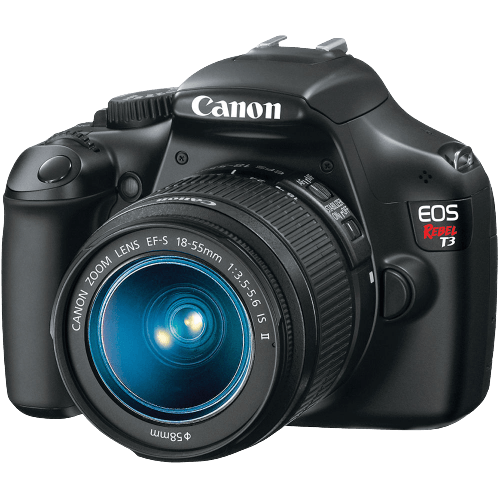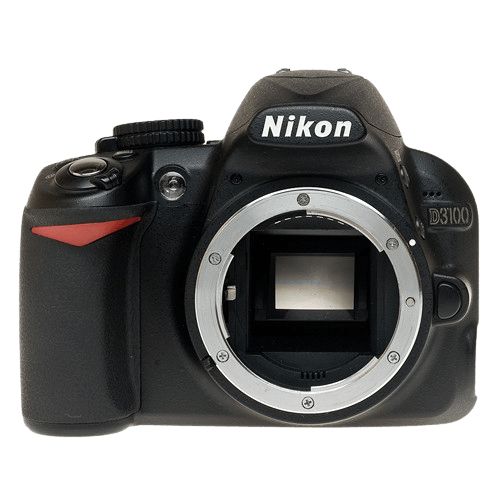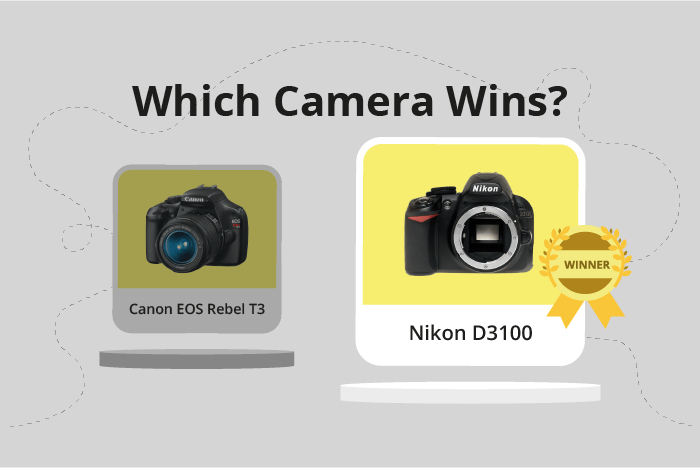Canon EOS Rebel T3 / 1100D vs Nikon D3100 Comparison
Canon EOS Rebel T3 / 1100D

Nikon D3100

The Nikon D3100 edges out the Canon EOS Rebel T3 / 1100D by just one point, scoring 41/100 compared to the T3’s 40/100. Both cameras are DSLRs, released in 2010 and 2011, with launch prices of $699 and $599 respectively. They share similar dimensions and weight, with the D3100 measuring 124 x 96 x 75mm and weighing 505g, while the T3 measures 130 x 100 x 78mm and weighs 495g.
The Nikon D3100’s higher score is due to its slightly better specifications, despite being an older model. It offers a better camera experience with a higher launch price than the Canon T3. On the other hand, the Canon T3 is more budget-friendly, with a lower launch price while still delivering competitive features.
Taking these factors into account, the Nikon D3100 slightly outperforms the Canon T3, but the T3 remains a solid option for those seeking a more affordable DSLR.
Canon EOS Rebel T3 / 1100D vs Nikon D3100 Overview and Optics
The Canon EOS Rebel T3 / 1100D wins the optics comparison with a score of 43/100, while the Nikon D3100 scores 41/100. Both cameras share some common specifications, such as a CMOS sensor, APS-C sensor size, 3 fps shooting speed, and no image stabilization. They also have their respective lens mounts, with the Canon featuring an EF-S mount and the Nikon using an F DX mount.
The Canon EOS Rebel T3 / 1100D has an edge with its Digic 4 processor, which contributes to its slightly higher optics score. Its 12.2-megapixel resolution, although lower than the Nikon D3100’s 14.8 megapixels, still delivers quality images. The Canon camera is also compatible with a wide range of EF-S lenses, providing versatility for various shooting scenarios.
On the other hand, the Nikon D3100 boasts a higher DXOMARK sensor score of 67, compared to the Canon’s 62. This indicates that the Nikon camera has a better sensor performance in terms of color depth, dynamic range, and low-light capabilities. Additionally, the Nikon D3100’s higher 14.8-megapixel resolution allows for more detailed images and larger prints.
While the Canon EOS Rebel T3 / 1100D takes the lead in optics with its higher score and Digic 4 processor, the Nikon D3100’s superior sensor performance and higher resolution should not be overlooked. Both cameras have their strengths and weaknesses, making the choice between them highly dependent on individual preferences and shooting requirements.
Canon EOS Rebel T3 / 1100D vs Nikon D3100 Video Performance
When comparing the video capabilities of the Canon EOS Rebel T3 / 1100D and the Nikon D3100, it is essential to note that the Nikon D3100 does not have video functionality. Therefore, this comparison focuses on the video capabilities of the Canon EOS Rebel T3 / 1100D.
The Canon EOS Rebel T3 / 1100D has a video score of 34 out of 100. The camera offers standard HD video resolution with maximum dimensions of 1280×720. The maximum video frame rate for the Canon EOS Rebel T3 / 1100D is 30 frames per second. However, this camera does not have built-in time-lapse functionality.
While the Nikon D3100 lacks video capabilities, the Canon EOS Rebel T3 / 1100D provides standard HD video resolution and a maximum frame rate of 30fps. Considering these factors, the Canon EOS Rebel T3 / 1100D is the only option for users seeking a camera with video functionality between these two models.
Canon EOS Rebel T3 / 1100D vs Nikon D3100 Features and Benefits
The Nikon D3100 emerges as the winner with a feature score of 36/100, slightly ahead of the Canon EOS Rebel T3 / 1100D, which scores 34/100. Despite the close scores, there are notable differences between the two cameras.
Both cameras share several specifications. Neither camera has a touchscreen, flip screen, GPS, WIFI, or Bluetooth. Additionally, both have the same screen resolution at 230,000 dots. However, the similarities end there.
The Nikon D3100 outperforms the Canon EOS Rebel T3 / 1100D in terms of screen size. The D3100 has a 3-inch screen, while the Rebel T3 / 1100D has a 2.7-inch screen. This larger screen size provides a better viewing experience when composing and reviewing images.
The Canon EOS Rebel T3 / 1100D does not surpass the Nikon D3100 in any specific feature. However, the close score indicates that the Rebel T3 / 1100D is still a solid camera despite its slightly lower score.
After examining the differences and similarities between the Nikon D3100 and the Canon EOS Rebel T3 / 1100D, it is clear that the Nikon D3100 has a slight advantage due to its larger screen size. While the Canon EOS Rebel T3 / 1100D is not far behind in scoring, it does not offer any features that surpass the Nikon D3100. Therefore, the Nikon D3100 is the better choice for those seeking a camera with superior features.
Canon EOS Rebel T3 / 1100D vs Nikon D3100 Storage and Battery
The Nikon D3100 triumphs over the Canon EOS Rebel T3 / 1100D in storage and battery, scoring 53/100 compared to the Canon’s 32/100. Both cameras share similarities in storage, having a single memory card slot and accepting SD, SDHC, and SDXC cards. Neither camera offers USB charging.
The Nikon D3100 outperforms the Canon T3 in battery life, providing an impressive 4500 shots per charge, using the EN-EL14 battery type. In contrast, the Canon T3 delivers 700 shots per charge with its LP-E10 battery. This significant difference makes the Nikon D3100 more suitable for extended shooting sessions without frequent battery replacements.
The Canon T3 does not hold any advantages over the Nikon D3100 in storage and battery. Its lower score reflects its weaker performance in this aspect.
Considering the storage and battery aspects, the Nikon D3100 is the clear winner. Its significantly longer battery life ensures you can capture more shots during your photography sessions, making it a more reliable option for photographers who prioritize battery performance.
Alternatives to the Canon EOS Rebel T3 / 1100D and Nikon D3100
Are you still undecided about which camera is right for you? Have a look at these popular comparisons that feature the Canon EOS Rebel T3 / 1100D or the Nikon D3100:

